Moonta's
vital statistics
Latitude
|
34
06s
|
Longitude
|
137
32e
|
Annual average rainfall
|
372.2mm
|
Population (2021 census)
|
5,217
|
Population
growth 1966 to 2021
|
2.1
per cent per year
|
Establishment
date
|
1861
|
Postcode
|
5558
|
Population changes over the years
Population censuses have been
conducted in South Australia
since 1881 and are now
conducted in Australia every five
years. Early census data is hard to
find and populations for urban
centres have not always been
provided. Older censuses used
electoral districts and/or local
government areas as their local
units. Data for the Moonta Town
Council area is reported for 1901,
1951 and 1961. However,
Council areas do not always
include contiguous urban areas.
The Australian Bureau of
Statistics introduced the Urban
Centre concept for the 1966
census and data based on that concept is reported for each subsequent census. Moonta's
population has grown steadily
since 1966, at an annual average
rate of 2.1 per cent. By 2021 the Census reported a population of 5,217.
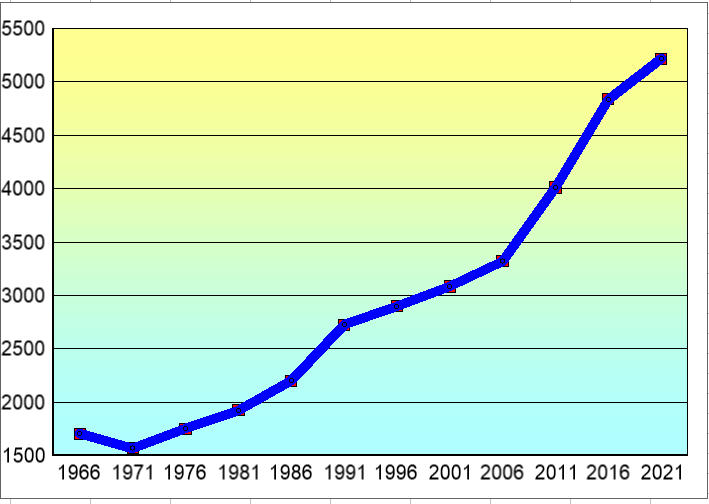
Census year |
Population |
Moonta Town Council area |
1901 |
1,607 |
1954 |
1,220 |
1961 |
1,151 |
Moonta (Urban centre concept) |
1966 |
1,702 |
1971 |
1,570 |
1976 |
1,751 |
1981 |
1,925 |
1986 |
2,199 |
1991 |
2,723 |
1996 |
2,898 |
2001 |
3,084 |
2006 |
3,322 |
2011 |
4,010 |
2016 |
4,839 |
2021 |
5,217 |
Moonta's labour force profile-2021 Census
Full time employed |
848 | Part time employed |
711 |
Away from work |
110 |
Unemployed |
128 |
Labour force |
1,794 |
Not in Labour Force |
2,408 |
Unemployment rate |
7.1% |
Labour force participation rate |
42.7% |
Data supplied by ABS and South Australian Year Books. Compiled by Canberra Media Research
Moonta is located on
the western side of northern Yorke Peninsula on the eastern shore of
Spencer Gulf. Its settlement dates back to 1861 only 73 years after
the First Fleet landed in Sydney Harbour and 25 years after the
foundation of the province of South Australia in 1836.
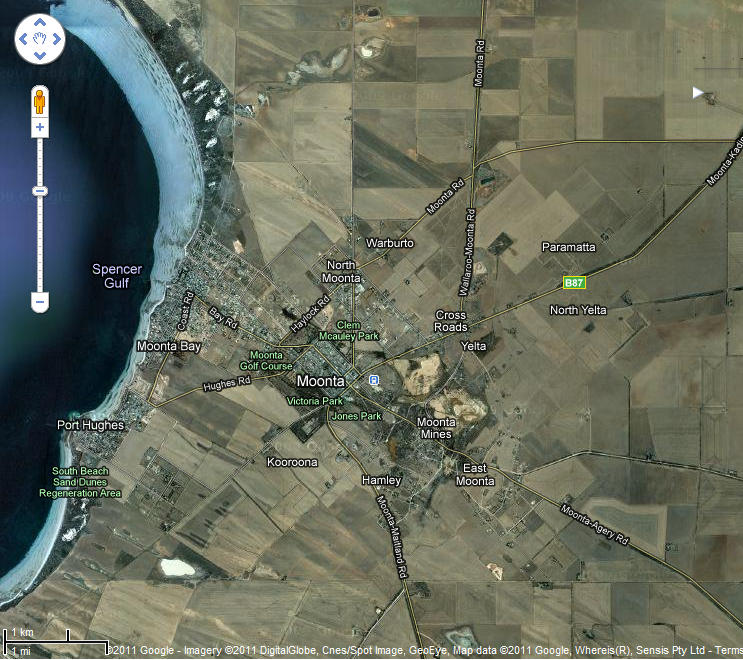
The discovery of
copper by a shepherd, Paddy Ryan, was the
initial impetus for Moonta's establishment.
Copper mining ceased in 1923 and the town became a service centre for
surrounding primary industries, notably wheat, barley and to a lesser
extent fishing. During the second world war a small munitions factory
contributed to Australia's war effort. In the 1950s caravan parks at
Moonta Bay and Port Hughes contributed to the development of
tourism and recreation. Since the 1970s holiday homes have
proliferated, especially in the beachside areas. As well the town has
become a popular retirement centre for persons from Adelaide and the
surrounding countryside. Copper was again mined in the 1990's for a
short time but was not a dominant contributor to the local
economy.
It's a great place
to visit!
Moonta has great beaches, a touch of history
and it's not expensive. Moonta has:
- two caravan parks (Moonta
Bay and Port
Hughes)
- a
museum
- an old time miners
cottage
- historical
railway
- mine tours
- an 18 hole golf course
- a "test" standard bowling
green
- tennis courts
- a shark proof sea swimming
pool
- two wooden jetties
- 3 country style pubs
- attractive public parks
- a cricket and Australian Football
oval
Moonta is not over commercialised, it's not
the Gold Coast, Noosa or even Batemans Bay, if anything it's a bit
under commercialised and that for many is its charm. In some
ways it's a bit like that place in the ABC series Sea Change.
However, Moonta's beaches are for swimming not surfing, as
Moonta is on a gulf it is protected from ocean swells. I have seen
bigger waves on Lake Burley Griffin.
Moonta's climate is mediteranian with mild
wet winters and dry warm summers. Summers days can be hot (over 40
degrees) but changeable. In summer it is not unusual to have a day of
40+degrees followed by one of 20 degrees. The rainfall, while not
high, is dependable and not affected by El Nino events as much as
areas in Eastern Australia.
Moonta is a well planned town with a central square and suurounding parks. Victoria Park on the southern edge of the town was planted in the 19th Century to protect the town from sand drifts and southerly winds. It's main vegetation is native pine, eucalypts and some pinus radiata. It was named after Queen Victoria. Today Moonta is growing rapidly and the Moonta Progress Association has been formed to promote the town and build a strong local community, for details click here.
Moonta is in the South Australian time zone
(-9:30 GMT) and observes daylight saving from November to
March. Use
this link to find the time in Moonta.
Tourist
information
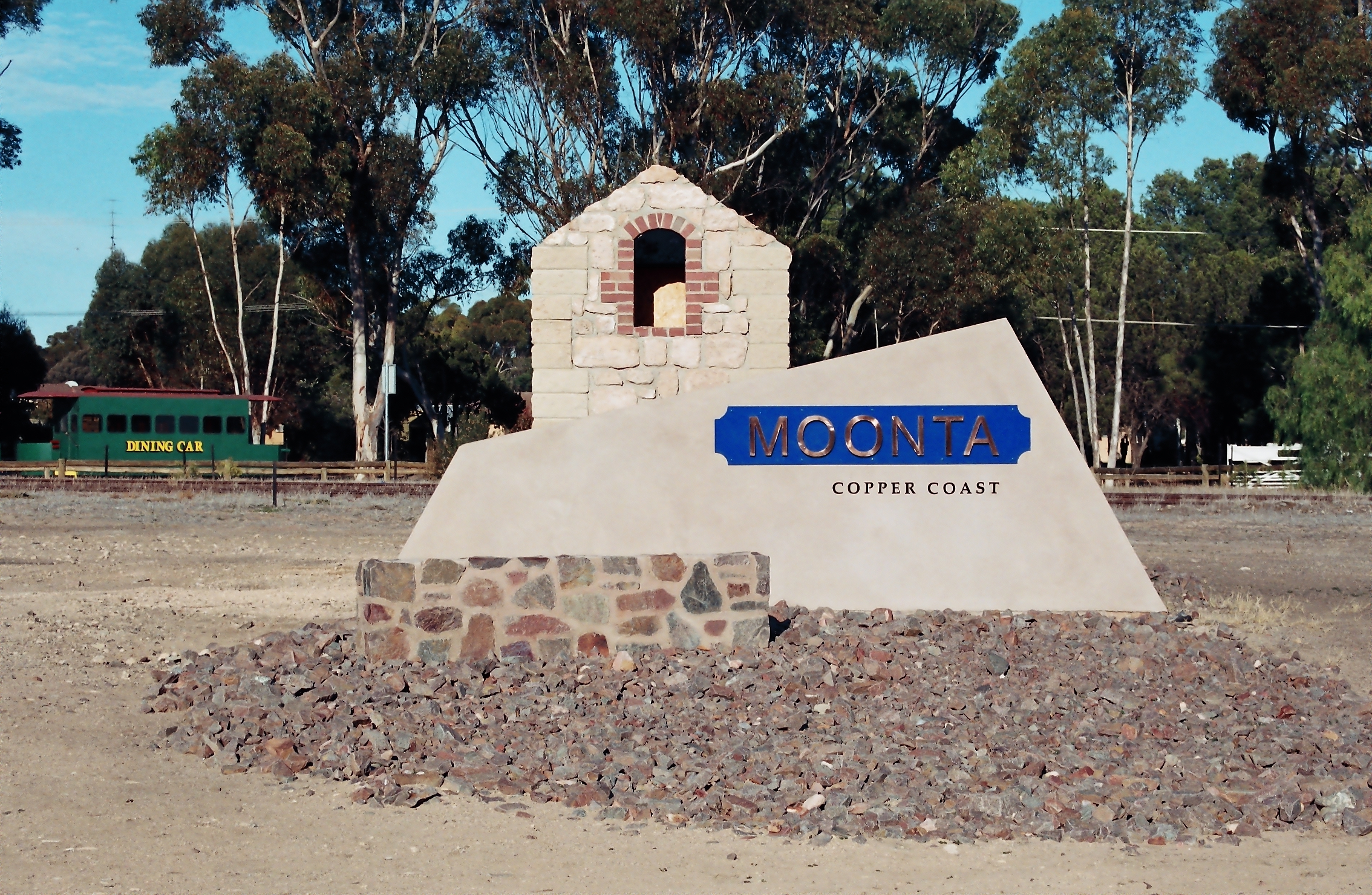
The Moonta Visitor Centre is located in the
old Railway Station (the last train to Moonta was in 1969) which
is on the northern side of the town just of the Kadina Road. It is
open 7 days a week from 9 to 17 hours, except Chrismas day. You can
obtain details on all local attractions and accommodation. Telephone
08 8825 2449
We had a great
time!
At the time of
visiting Moonta, at Christmas 1996, we were a family of 2 adults and
four children (aged between 6 - 14). We visited Moonta as part of a
visit South Australia. We visited South Australia because Dad had
been there a lot when he was young man and he talked about it a lot.
He said that we should see Moonta.
We spent a week
at Moonta. It was very hot, however we had a good size cabin that was
nice and cool. We can’t remember if it was air-conditioned. Our
cabin was right next to the beach, which was great because we spent a
lot of time there. A man at the garage gave Dad a car tyre tube for
free and we had a great time with that on the
beach.
The beach was
great fun because the waves were small and you did not get sucked
out. Every day we went swimming early and when we were tired we
fished and most times we got something to eat for
breakfast.
After we had
been swimming and had breakfast we would play around the cabin or
have a look at Moonta or some of the other towns around there. Moonta
was interesting because of all the old houses and the mines we
visited. Tom, the second oldest boy in our family loves to collect
rocks and he got a lot of them there, he still has lots of peacock
ore. There was a good miniature train ride. Around the mine were some
old buildings and Mum told us some interesting stories like how the
family lived in a cottage that had a dirt floor, how all the children
died after they were poisoned from the water and how copper was
discovered at Moonta
The shops had a
lot of interest things for lunch, we had Cornish pasties a lot for
lunch and we found a good place for fish and
chips.
We also visited
some places around the area. Some of the things we remember are,
driving on the beach, seeing a giant squid, visiting an old
bank.
We would like
to go back to Moonta mainly because of the great beach and having a
cabin so close. We spent a lot of time there mostly in the morning
and evening. One evening we were still swimming when the sun went
down into the sea. We hope that we will get back there
soon.
Parents
comments
The kids
enjoyed Moonta and consequently so did we. The beach suited the kids
each
Great
weather
Go for a swim
when you need a rest, throw a line an and catch
one
Interesting
history, which is evident everywhere from the houses, Cornish
cuisine, old mining building."
The Heazlewood family: Cook
ACT
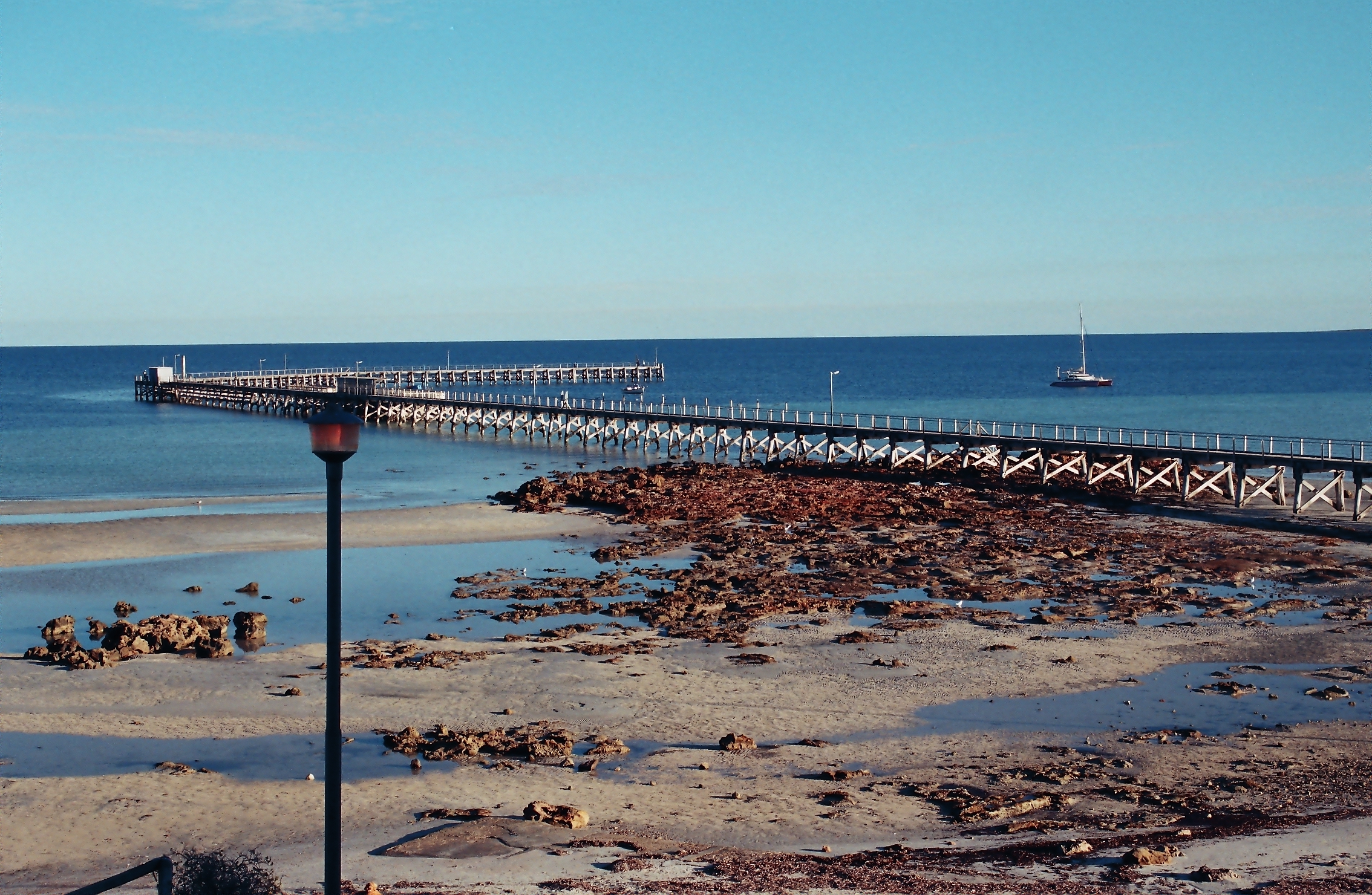
How do you get there?
By
Road:
From
Queensland, NSW and the ACT-Get onto highway 20 turn off to Morgan at
Renmark and go through to Port Wakefield and turn off Highway
1, just after going through Port Wakefield, the sign will tell
you the way.
From Victoria and
Tasmania-Go through Adelaide onto Highway 1 and turn off just after
Port Wakefield.
From Western
Australia and Northern Territory-Turn off Highway 1 at Port Pirie and
go through Port Broughton and Wallaroo.
By
Bus:
Buses
leave twice daily except on Weekends from the Franklin Street Bus
Station in Adelaide (Premier
Stateliner)
Political
Federal
Moonta is in the Federal Division of
Grey, a seat held by Tom Venning of the Liberal Party.
State
Moonta is in the State of South Australia
and is included in the State electorate of Narungga, the current
member is Mr Fraser Ellis, Independent.
Local Government
Moonta is in the District Council of the
Copper Coast presided over by Her Worship the Mayor Roslyn Talbot.
Copper
Mining: a tempetuous history
Copper mining started around 1861 some 12 to
18 months after discoveries in nearby Wallaroo Mines. The principal
developer was William Watson Hiughes who together with four other
shareholders formed the Wallaroo and Moonta Mining companies. The
early days were dominated by legal and political disputes about
ownership and leases. Despite these diversions the mines prospered,
particularly the Moonta
Mines. They were the first company
in South Australia to pay one million pounds in dividents or in
decimal currency two million dollars.
Flinders University historian Patricia
Sumerling has undertaken
considerable research into the early
mining days and can be contacted on 61-8-8362 8262 for further
details. Her research resulted in a thesis entitled William Watson Hughes and the Moonta and Wallaroo Mines. The thesis is only available at the Flinders University Library Bedford Park South Australia. She intends to publish a synopsis some time in the future.
The halcyon years were 1861 to 1870 when the
richest lodes were mined. After then the mines faced stiff
competition from mines in Chile. Mining continued until 1923.
But there was always talk that there was more copper to be
won. In the 1960s Western Mining set up a lab in Moonta to assess ore
from test drillings. An open cut mine was eventually established in
the Yelta
area. However, with electricity, technology and capital equipment
most of the ore was mined in a few short years (it has been claimed
as much as was mined in the 1861-1923 period). The mine is now closed
and is open to tourists.
The Moonta mines made an important
contribution to Australia's economy. They were crucial to the
prosperity of the fledgling economy of the province of South
Australia and were equivalent to the gold rushes in other parts of
Australia. Money from the Moonta Mines helped to establish the
University of Adelaide.
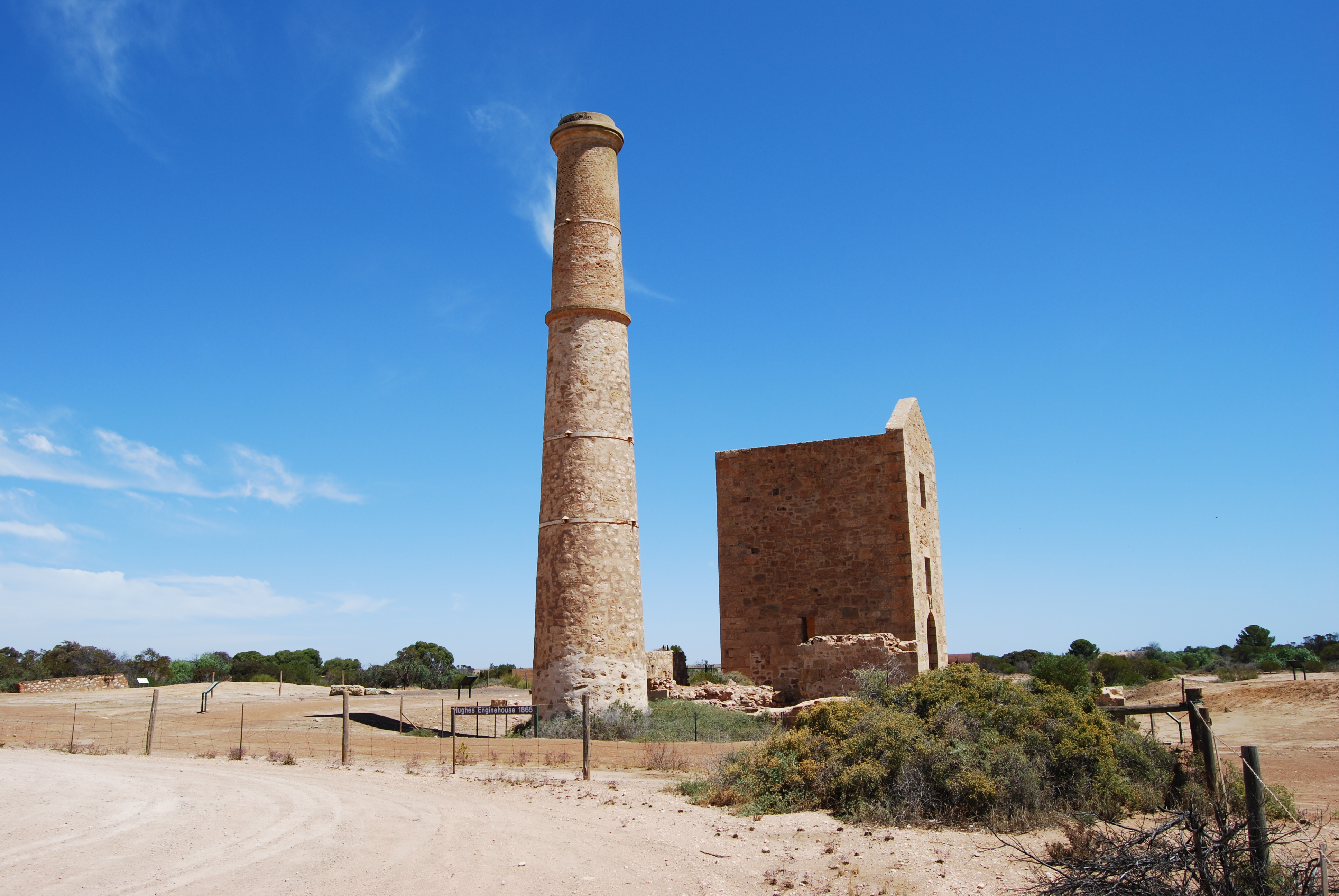
The Hughes pumping station, Moonta Mines
The establishment of a School of
Mines in Moonta was one of the first steps towards providing
comprehensive vocational training in Australia. The skills of the
Moonta miners added to Australia's skill base in terms of mining
engineering, management and financing.
Moonta's
name honoured
Moonta's contribution to Australia
has been recognised through Street names in both Canberra and
Adelaide. There is a Moonta Place in the Canberra suburb of Fisher,
which has a mining town theme to its street names. In Adelaide Moonta
Street runs between Grote and Gouger Streets and is now the centre of
Adelaide's Chinatown
There were 3 vessels named Moonta. The first was a barque, it was mentioned in the Wallaroo and Kadina Times 16 December 1868: The vessel MOONTA 627 tons, one of the Black Diamond Line was selected to convoy the Northern Territory Party.
The ship Moonta under Captain Barneson was chartered to take Surveyor-General Goyder's northern expedition to Port Darwin.
The second a screw steamer, Moonta built 1892 by W Dobson and Company, Newcastle on Tyne in England and from 1899 until 1913 sailed by the name La Serena. It weighed 2,266 tons and had a speed of 8 knots. The Moonta was eventually sold, going to Japan to be scrapped in 1931. 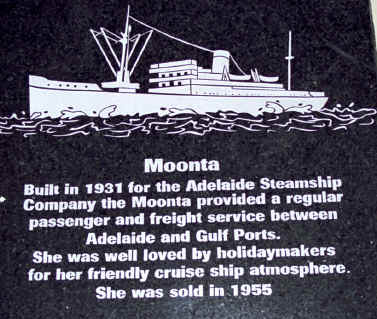 The third MV Moonta operated from 1931 to 1955. It was built in Copenhagen (Denmark) and had a speed of 12.5 knots and weighed 2,993 tons. M V MOONTA was built for the Adelaide Steamship Company the Moonta provided a regular passenger and freight service between Adelaide and Spence Gulf ports. The Moonta was 285 ft long and could transport up to 146 persons - she was eventually sold in 1955 to a Greek company who renamed her LYDIA and ended up being beached in Southern France for use as a Casino. The picture from a commemorative plaque in Port Lincoln describes the second Moonta. Both ships were operated by the Adelaide Steamship Company.
The third MV Moonta operated from 1931 to 1955. It was built in Copenhagen (Denmark) and had a speed of 12.5 knots and weighed 2,993 tons. M V MOONTA was built for the Adelaide Steamship Company the Moonta provided a regular passenger and freight service between Adelaide and Spence Gulf ports. The Moonta was 285 ft long and could transport up to 146 persons - she was eventually sold in 1955 to a Greek company who renamed her LYDIA and ended up being beached in Southern France for use as a Casino. The picture from a commemorative plaque in Port Lincoln describes the second Moonta. Both ships were operated by the Adelaide Steamship Company.
The above information was kindly supplied by the Australian National Maritime Museum-Darling Harbour Sydney.
Australia's
little Cornwall
The people of Cornwall in England have been
mining copper and tin since the days of the Roman Empire. They were
mining experts. The discovery of rich lodes of ore in Australia
together with declining yields in Corwall led to many Cornish people
migrating to Australia, especially Moonta. Cornish miners
brought their culture with them and Moonta became a Cornish enclave.
The Cornish are a Celtic people as are the Irish, Welsh, Scots and
the inhabitants of Brittany in France. Until the 1770s they had their
own language which some people in Cornwall are trying to revive
today.
Moonta's Cornish hertitage is now celebrated
through the Kernewek
Lowender Festival held every two
years (the odd year). The last Kernewek Lowender was held in May 2023. The next will be held in 10th to 16th May 2027.
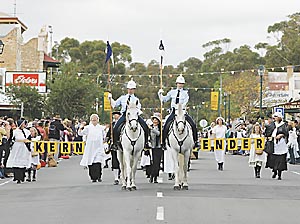
One of the floats in Moonta's parade at the
2005 Kernewek Lowender. Photo supplied by the Yorke Peninsula Country Times
Cornish
Pasties-Fast Food and a culinary
delight
"In Moonta, South Australia where the
Cornish population mined copper last century (19th), are the finest
Cornish pasties in the land. Freshly baked and served with home-made
relish, I've been known to have very aromatic hand luggage on my
flights home."
Susan Parsons-Food and Wine Supplement
Canberra Times 29 December 1999
You can buy pasties (sometimes Cornish pasties) in most parts of
Australia, but are they genuine? Why not make your own and get a
taste of the real thing. The recipe for the Moonta Cornish pasty
is:
Pastry
(Ensure that pastry is
soft and elastic)
250g self raising flour, 85g fat (1/2 Lard-1/2 Margarine)(All
Margarine if on low cholesterol diet) and a pinch of salt
Filling
Chuck steak cut finely-not minced Small potato, turnip, 1/2
onion, salt and pepper to taste. Vegetables need to chipped not
diced or minced
Putting it together
Roll out the pastry to about 15cm diameter and place ingredients into
layers, turnips first then potato, meat, salt and pepper, onion then
more potato. Then close pastry over ingredients in the usual pasty
shape. Prick a small hole to allow steam to escape and glaze with
milk. Place in oven heated to 220 degrees celsius for 10 minutes then
turn down to 190 for another 20 minutes. When taken out of oven let
them stand for 5 minutes to allow steam to soften ingredients and
improve the flavour.
Moonta: Hotbead
of Methodism
In the late 18th Century various sects arose
as a result of the activities of Anglican preachers John and Charles
Wesley. These were the Methodists. With their empathy for the poorer
classes of England they attracted converts among miners, particularly
those in Cornwall. When they came to Moonta they brought their
religion with them. Originally, there were many sects of Methodism in
Moonta which led to the creation of up to 5 Methodist churches in the
area. Today two survive, these are the Moonta Mines church in the
Moonta Mines area and the town church in Robert Street. The Moonta
Mines Church was built in 1865, just 4 years after the discovery of
copper. It is one of the largest churches in Australia with a seating
capacity of 1,200 (two levels of seating). The Canberra theatre can
seat 1,500. The Moonta Methodist church is also quite
large.
The Church in Moonta Mines was remarkable in
the sense that it was probably built by church goers who did hard
physical work all day in the mines and then built their own cottages
in their spare time. That they could also build a large church in
such a short time is a tribute to their faith. They did not need a
City to Surf run to keep fit.
The Moonta Methodists had a large impact on
the politics of South Australia particularly through their
involvement in the labour movement. Early methodists were opposed to
all forms of gambling and alcohol. South Australia has a religious
composition quite different to other Australian States. It has more
protestants (mainly non-conformist and Lutheran) and fewer
Catholics.
Both of the Moonta Methodist churches are
now part of the Uniting church which was formed in 1978 out of the
Methodist, Congregational and Presbyterian denominations. According to the 2001 Census 30 per cent of Moonta people cite the Uniting church as their religion.
Moonta does have other churches. There is an
Anglican church on Milne Terrace and a Catholic church in Robert
Street.
A world
political first: the Moonta
connexion
In the 1910 South Australian elections the
Australian Labor Party won a majority of seats in the House of
Assembly, the lower house of the South Australian Parliament. It was
the first such victory for a labour party anywhere in the world. The
labor leader, and new South Australian Premier was John Verran, a
Moonta resident and member for Wallaroo (the electorate that included
Moonta).
John Verran was born on the ninth of August
1856 in Gwennap Cornwall. His family migrated to Australia in 1857
and lived in Kapunda (South Australia) before moving on to Moonta. At
the age of ten he started work in the Moonta Mines as a "pickey table
boy". His education was rudimentary but the ministers of the
Primitive Methodist church encouraged him to read and take an
interest in trade unionism. He later went on to lead the Amalgamated
Miners' Association (1895-1913) and stood for Parliament on several
occasions. In 1901 he won the seat of Wallaroo for Labor and became
its leader in 1909.
His Government had mixed success. It
developed railways and harbors and allowed the State Bank of South
Australia to grant loans to poorer people. However, it had
considerable problems with the upper House (the Legislative Council)
and was bedevilled by industrial disputes. The Government only lasted
two years.
Having lost the election he resigned from
the Labor leadership and left the Labor Party over the conscription
issue during the first world war. He was succeeded in the seat of
Wallaroo by RS Richards who also become a Labor Premier in the 1930s.
More information on John Verran can be found in the Australian
Dictionary of Biography.
Another
first: a hanging offence
Elizabeth Woolcock was the first, and only
women, to be hanged in South Australia. At the time of her conviction
she lived in East Moonta, one of the early mining areas. She was
tried and convicted for the murder of her husband Thomas Woolcock.
Elizabeth Woolcock originally came from the Victorian goldfields
where she had a troubled childhood. She came to Moonta to live with
her mother and eventually married Thomas Woolcock. However, she was
reputedly subjected to what we now call domestic violence and decided
to poison her husband with mercury compounds. She was hanged at
Adelaide Gaol on 30 December 1873 aged just 25 (seven years before
Ned Kelly was hanged). The East Moonta area where she lived was known
as poison flats for many years after.
Fortunately, capital punishment was
abolished in South Australia in 1975, just more than 100 years after
Elizabeth's execution. The story of her life is well documented in
Allen Peters's book "No Monument of Stone" printed by the Lutheran
Publishing House-Adelaide and published by the author.
It is available from the author at
Allanpeters@Picknowl.com.au. or A.
L. Peters 8 Archer St. Christies Beach. South Australia
5165
Early
exploration and the original inhabitants of Moonta
The first European to come anywhere near Moonta was the British
explorer Matthew Flinders who charted the coast of Southern Australia
in his ship the Investigator. He named the Gulf on which Moonta is
located Spencer Gulf (after the British Spencer family of whom the
late Princess Diana was a descendent).
The French were also interested. Their navigators (Freycinet and
Boudin) explored the Southern Australian Coast and named the Gulf,
Golfe de Bonaparte after Napoleon Bonaparte who was to later become
Emperor of France. However, Flinders was first so the people of
Moonta eat pasties not croissants.
Moonta was original inhabited by the Narangga people who called
the area Monta-Montarra which means thick scrub. Therefore, Moonta in
common with many other cities and towns in Australia has an
Aboriginal name.
The Narangga resisted early European settlement by spearing
shepherds and their sheep. However, there was swift and
indiscriminate retaliation by the settlers. In 1868 the Point Pearce
mission was established, about 30 kms south of Moonta, which became
the home of the Narangga.
Read
about Moonta and its people
Moonta's colourful history is set out in a
number of books. These are listed below, some are available from the
Visitor Information Centre and would certainly be kept by major
libraries such as the State Library of South Australia (North Terrace
Adelaide) and the National Library in Canberra. They are also likely to be available from the tourist centre and local newsagents.
Title |
Author |
Publisher/Comments |
Growing up Moonta |
Kristen Weidenbach |
History of Moonta from the perspective of the Weidenbach family |
Australia's Little Cornwall |
Oswald Prior |
National Trust/The definitive story about Moontas's early days, Mining,
Cousin Jacks and others |
Cornish Pasty |
Oswald Prior |
Publisher not known/A book of cartoons on Moonta's Cornish miners
|
Not Only in Stone |
Phyliss Somervale |
Wakefield press/A novel based on a family who emigrated from Cornwall
to the Moonta Mines, it's a good story of hope, tragedy and human endurance
|
Cap'n 'Ancock |
Mandie Robinson |
Rigby/The story of Captain Hancock, a long standing manager of the
Moonta Mines and a larger than life character |
No Monument of Stone |
Allen Peters |
Published by the author/The story of Elizabeth Woolcock (see story
above) |
Cornish Heritage |
Jim Faull |
Published by the author/a novel about a cornish miner who comes to
Moonta |
Licorice and All Sorts |
Ben Sims |
Published by the author/an autobiograpy of Ben Sims, of the Sims Cove
fishing family (Sims cove is near moonta Bay) |
It's
time to go home
 The third MV Moonta operated from 1931 to 1955. It was built in Copenhagen (Denmark) and had a speed of 12.5 knots and weighed 2,993 tons. M V MOONTA was built for the Adelaide Steamship Company the Moonta provided a regular passenger and freight service between Adelaide and Spence Gulf ports. The Moonta was 285 ft long and could transport up to 146 persons - she was eventually sold in 1955 to a Greek company who renamed her LYDIA and ended up being beached in Southern France for use as a Casino. The picture from a commemorative plaque in Port Lincoln describes the second Moonta. Both ships were operated by the Adelaide Steamship Company.
The third MV Moonta operated from 1931 to 1955. It was built in Copenhagen (Denmark) and had a speed of 12.5 knots and weighed 2,993 tons. M V MOONTA was built for the Adelaide Steamship Company the Moonta provided a regular passenger and freight service between Adelaide and Spence Gulf ports. The Moonta was 285 ft long and could transport up to 146 persons - she was eventually sold in 1955 to a Greek company who renamed her LYDIA and ended up being beached in Southern France for use as a Casino. The picture from a commemorative plaque in Port Lincoln describes the second Moonta. Both ships were operated by the Adelaide Steamship Company.




